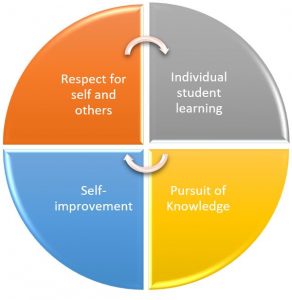I am all about learning.

I facilitate individual student learning by identifying the unique characteristics of each student and offering a blend of instruction, coaching, and mentoring to support their individual educational development so that they can achieve “bonitatem, disciplinam, scientiam” — goodness, discipline and knowledge. For me, education is a highly humanistic and individualized experience in which both teachers and students are responsible for learning. I teach to help students find their own pathway to success — both inside and outside of the classroom — by emphasizing individual student learning, the pursuit of knowledge, self-improvement, and respect for self and others.
Let me begin by telling a story of how my daughter Anna, during her home-schooled experience, learned about primates. She was fascinated and wanted to learn all about these animals so we took out every book in our public library on primates. She learned that gorillas are closely related to humans and that they are endangered, which led her to mount a small fund-raising campaign to adopt a gorilla named “Afrika” through the Dian Fossey Gorilla Fund. She subsequently created a library display and gorilla scrapbook, and became our local resident on gorillas and primates. The crowning achievement was when she got to meet Jane Goodall, who focused throughout her long career on the plight of chimpanzees. It is not something that could have been presented in a one or two-hour lesson plan or unit study. It was neither ordered nor planned. My wife and I worked with her to remove any barriers and encouraged her to follow her interests as far as they would take her. In the end, she learned an immense amount about primates, their place in the world, and how each of us can help sustain a challenged species. She also took some of her first steps to becoming an independent learner, a world citizen, and a vegetarian. To this day, she remains connected with the Dian Fossey Gorilla Fund. I tell this story because it shows how important encouragement of educational curiosity and providing supportive learning environments are to fostering individual student learning.
This experience with my daughter led me to the insight that students attend university for many purposes. Students often identify the pursuit of knowledge as one of their top reasons. My teaching looks to put students on an educational journey that emphasizes cognitive learning, experiential and service learning, skill building, and reflection. For me, it is all about the journey. I want my students to have a journey that challenges what they know and believe so that they can reach their full potential and make a positive difference in our world.
Our university community has become increasingly diverse in recent years. Today, we have more than 4,000 international students enrolled from approximately 100 different countries. We also see increasing student populations of Indigenous learners, first-generation students, mature students, new immigrants, and college/university transfer students. Our faculty and staff come from all parts of Ontario, Canada, and the global community. No longer can we use one “best” teaching and assessment practice to teach our students. My teaching celebrates difference and explores continuously how to enhance learning in our multicultural and multi-ability educational environment. One of the best ways of achieving this is by ensuring respect for self and others. I use teaching practices that enhance understanding of diversity, inclusion, and difference. I also help students employ self-care to manage the stresses that come from formal academic studies.
An important part of learning is self-improvement. My hope is that students will obtain through my teaching a passion for life-long learning. I work toward enhancing student affection for, and interest in, education — encouraging resilience by using continuous feedback. There are days of success and failure, but in the end, I hope to instill in my students a commitment to continuous self-improvement. I believe I must also expect the same of myself. I believe the mark of every good teacher is her or his commitment to always improving teaching, modelling the self-improvement we expect from our students by welcoming feedback on our teaching.
My greatest thrill is to see students achieve their potential. For some, this is easy: just get out of the way and watch their learning take off. For others, it may involve helping them to work through mental or physical health challenges. We all have strengths and limitations. That is the way of the human condition. Teaching involves helping students to identify both and support their growth in ways that permit the fulfillment of their unique potential. This can be done by creating educational environments that enhance learning and by engaging students individually in ways that inspire them.
Recent Comments